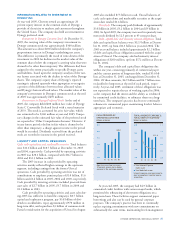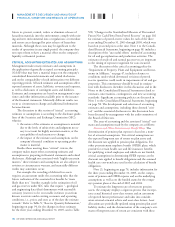Chevron 2005 Annual Report Download - page 43
Download and view the complete annual report
Please find page 43 of the 2005 Chevron annual report below. You can navigate through the pages in the report by either clicking on the pages listed below, or by using the keyword search tool below to find specific information within the annual report.
CHEVRON CORPORATION 2005 ANNUAL REPORT 41
and others and net of liabilities recorded by Equilon or Motiva
prior to September 30, 2001, for any applicable incident.
In the acquisition of Unocal, the company assumed
certain indemnities relating to contingent environmental
liabilities associated with assets of Unocal’s 76 Products Com-
pany business that existed prior to its sale in 1997. Under the
terms of these indemnities, there is no maximum limit on the
amount of potential future payments by the company; how-
ever, the purchaser shares certain costs under this indemnity
up to an aggregate cap of $200 million. Claims relating to
these indemnities must be asserted by April 2022. Through
the end of 2005, approximately $113 million had been applied
to the cap, which includes payments made by either Unocal or
Chevron totaling $80 million.
Securitization The company securitizes certain retail and
trade accounts receivable in its downstream business through
the use of qualifying special purpose entities (SPEs). At
December 31, 2005, approximately $1.2 billion, representing
about 7 percent of Chevron’s total current accounts receivable
balance, were securitized. Chevron’s total estimated fi nancial
exposure under these securitizations at December 31, 2005,
was approximately $60 million. These arrangements have
the effect of accelerating Chevron’s collection of the securi-
tized amounts. In the event of the SPEs experiencing major
defaults in the collection of receivables, Chevron believes that
it would have no loss exposure connected with third-party
investments in these securitizations.
Long-Term Unconditional Purchase Obligations and
Commitments, Throughput Agreements and Take-or-Pay
Agreements The company and its subsidiaries have certain
other contingent liabilities relating to long-term uncondi-
tional purchase obligations and commitments, throughput
agreements, and take-or-pay agreements, some of which
relate to supplier’s fi nancing arrangements. The agreements
typically provide goods and services, such as pipeline and
storage capacity, utilities, and petroleum products, to be used
or sold in the ordinary course of the company’s business.
The aggregate approximate amounts of required payments
under these various commitments are: 2006 – $2.2 billion;
2007– $1.9 billion; 2008 – $1.8 billion; 2009 – $1.8 billion;
2010 – $0.5 billion; 2011 and after – $3.8 billion. Total pay-
ments under the agreements were approximately $2.1 billion
in 2005, $1.6 billion in 2004, and $1.4 billion in 2003. The
most signifi cant take-or-pay agreement calls for the company
to purchase approximately 55,000 barrels per day of refi ned
products from an equity affi liate refi ner in Thailand. This
purchase agreement is in conjunction with the fi nancing of
a refi nery owned by the affi liate and expires in 2009. The
future estimated commitments under this contract are: 2006
– $1.3 billion; 2007 – $1.3 billion; 2008 – $1.3 billion; and
2009 – $1.3 billion. In 2005, under the terms of an agree-
ment entered in 2004, the company exercised its option to
acquire additional regasifi cation capacity at the Sabine Pass
Liquefi ed Natural Gas Terminal. Payments of $2.5 billion
over the 20-year period are expected to commence in 2009.
Minority Interests The company has commitments of
approximately $200 million related to minority interests in
subsidiary companies.
The following table summarizes the company’s signifi -
cant contractual obligations:
Contractual Obligations
Millions of dollars Payments Due by Period
2007– After
Total 2006 2009 2010 2010
On Balance Sheet:
Short-Term Debt1 $ 739 $ 739 $ – $ – $ –
Long-Term Debt1,2 11,807 – 8,775 176 2,856
Noncancelable Capital
Lease Obligations 324 – 154 36 134
Interest Expense 5,600 500 1,100 300 3,700
Off-Balance-Sheet:
Noncancelable Operating
Lease Obligations 2,917 507 1,194 284 932
Unconditional Purchase
Obligations 1,200 500 600 100 –
Throughput and
Take-or-Pay Agreements 10,800 1,700 4,900 400 3,800
1 $4.9 billion of short-term debt that the company expects to refi nance is included in
long-term debt. The repayment schedule above refl ects the projected repayment of the
entire amounts in the 2007–2009 period.
2 Includes guarantees of $247 of LESOP (leveraged employee stock ownership plan) debt,
$14 due in 2006 and $233 due after 2006.
FINANCIAL AND DERIVATIVE INSTRUMENTS
Commodity Derivative Instruments Chevron is exposed to
market risks related to the price volatility of crude oil, refi ned
products, natural gas, natural gas liquids and refi nery feed-
stock. The company uses derivative commodity instruments
to manage these exposures on a portion of its activity, includ-
ing fi rm commitments and anticipated transactions for the
purchase or sale of crude oil; feedstock purchases for company
refi neries; crude oil and refi ned products inventories; and
fi xed-price contracts to sell natural gas and natural gas liquids.
Chevron also uses derivative commodity instruments for
trading purposes. The results of this activity were not mate-
rial to the company’s fi nancial position, net income or cash
fl ows in 2005.
The company’s positions are monitored and managed
on a daily basis by an internal risk control group to ensure
compliance with the company’s risk management policy that
has been approved by the Audit Committee of the company’s
Board of Directors.
The derivative instruments used in the company’s risk
management and trading activities consist mainly of futures,
options, and swap contracts traded on the New York Mer-
cantile Exchange and the International Petroleum Exchange.
In addition, crude oil, natural gas and refi ned product swap
contracts and option contracts are entered into principally
with major fi nancial institutions and other oil and gas com-
panies in the “over-the-counter” markets.
Virtually all derivatives beyond those designated as normal
purchase and normal sale contracts are recorded at fair value on
the Consolidated Balance Sheet with resulting gains and losses
refl ected in income. Fair values are derived principally from
market quotes and other independent third-party quotes.
Each hypothetical 10 percent increase in the price of
natural gas and crude oil would increase the fair value of the
natural gas purchase derivative contracts by approximately
$33 million and reduce the fair value of the crude oil sale
























